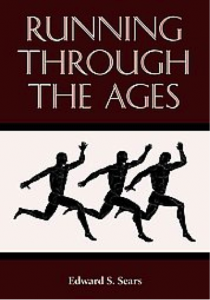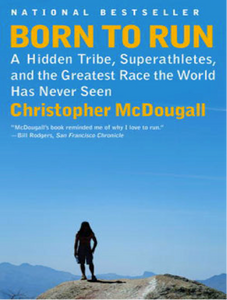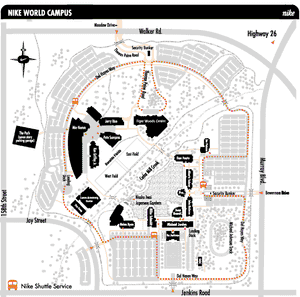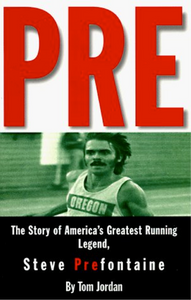Current Nike T-Shirt. A common joke among runners.
Although this video is not academic, it is an introduction to the idea that the popularization began in the 1970s.
Click here for Introductory video
Introduction:
Non-competitive running hasn’t always been an activity enjoyed by the majority of the American population. It began in the United States as a sport enjoyed only in youth programs, colleges, or at professional levels. But in the 1970’s the nation rapidly grew interested in participating in the sport as amateurs. This heath kick did not become a fad, but a movement. National athletic celebrities such as Steve Prefontaine and Joan Benoit stimulated interest in the sport. The union of Bill Bowerman and University of Oregon track and field with the creation of Nike marketed the activity. Publications taught and argued for the benefits of jogging. Historical and anatomical studies argued the natural skill of jogging that belonged to humans. Jogging was no longer done only for necessity. Running became mainstream and fun.
This research guide is a compilation of information meant to help the researcher navigate through the popularization of running in the 1970s, as well as the causes previous and the effects after.
General Overview:
These sources provide a general overview of the popularization of running in America. They are good sources to start with because they include all of the aspects that contributed. Within these sources there is reference to the scientific studies which have promoted running. These studies include anatomical and evolutionary research that say humans were meant to be distance runners and barefoot running is good for the feet. These references also include the Nike movement and the first shoe worn in a race by Steve Prefontaine- which sparked the athletic market and made running accessible to all people. Lastly, the provide record of famous runners, running events (such as Olympic trials in Oregon and races around the world), and running advocates, and the setting of America which inspired people to run in there daily lives.
Type of Source:
Books:
–Running Through the Ages
Edward S. Sear’s book is a chronological description of the history of running. It is a general description and a very good place to start research. The pertinent parts to the popularization of running in America are Chapters 5-7. The book itself is rather lengthy so it is best for the researcher to begin on page 80. Chapter 5 is the “Golden Age of Pros and the Rise of Amateurs,” chapter 6 describes the period of 1900-1950 in “Modern Running Goes Worldwide,” and Chapter 7 finishes with “The Modern Superstars 1950-2000.” His book is a great overview of the the scientific studies that caused people to believe running is necessary, the influence of track, new athletic markets, and the appeal that American’s found in running.
Sears, Edward S. Running Through the Ages. Jefferson, North Carolina: McFarland and Company Inc Publishers, 2001.
-Strides: Running Through History With an Unlikely Athlete.
Benjamin Cheever discusses the natural history of running from the ancients, to soldier’s 10ks, to the worlds best distance runners, and to the every day runner. To do this he covers an enormous span of time. What is crucial to the popularization of running in America is chapter 5, it discusses the scientific studies that popularized running by arguing that humans were designed for running. The next chapter to check out is Chapter 14 which specifically discusses American running. Lastly, a researcher should check out chapter 23 and its discussion of running’s appeal to everyone, which became known during the running phenomenon.
Cheever, Benjamin. Strides: Running through History with an Unlikely Athlete. New York, NY: Rodale , Inc., 2007.
-Born to Run
Christopher McDougall describes many important aspects of the popularization of running within his narrative. He is writing a journalistic report about finding the Taramuhara tribe with a group of runners and participating in an ultra-marathon race. During his narrative he covers scientific studies covering the argument for man being natural distance runners, aka people are “born to run.” He also covers the involvement of the running shoe movement and pop culture that revolutionized running in the 1970s. In addition to these concepts he debates the barefoot running movement that has been debated for the last in recent years.
McDougall, Christopher. Born to Run. New York: Alfred A Knopf, Random House, Inc., 2009.
Documentary:
-Tarahumara: A hidden Tribe of Super athletes Born to Run
This video is about Christopher McDougall’s Born to Run. Discovery channel describes his book and interviews the author regarding the topics.
Scientific Studies:
Part of running’s popularity among American public was due to the interest in running among intellectuals. Evolutionary, anatomical, and anthropological scientists all came to take an interest in running. The natural history of running among humans is the study that says humans hunted by being distance runners. Part of this study is the design of human bodies which enable us to run, it is believed factors such as sweating and bipedalism allowed for humans to run natural at ultra marathon distances everyday. Spawning from this came the study of barefoot running. It is believed modern man is causing injuries by running in shoes and not allowing natural development of the feet. These sources cover these important topics in the running world that contributed to the popularization of running that really took off with 1970s.
Type of Source:
Book:
-Why we Run: A Natural History
Richard Benyo’s book is a good reference to understanding the scientific appeal of running that really allowed it to become a phenomenon. He discusses how humans have evolved to be natural born distance runners. He argues humans pre-industrialization ran ultra marathon distances to hunt. They literally ran their prey to death. These studies spark the barefoot and distance running revolutions. Americans gained confidence through these studies and appeal in running increased.
Website:
-Evolution of Human Running
This website discusses the argument that humans evolved to be distance runners. It describes the natural history and anatomical evidence that inspired Americans to run.
Documentary:
-The Evolutionary History of Jogging
Within this video Dr. Daniel Schmitt, an Evolutionary Anthropologist at Duke University describes the studies relating to humans natural abilities in running.
Nike’s Involvement:
Nike began as Blue Ribbon Sports in the 1970s and was started by Phil Knight and Bill Bowerman. They each contributed 500 dollars to start the now worldwide company that made amateurs able to run. Nike marketed through popular athletes and sex symbols such as Steve Prefontaine, which made running appealing. These sources provide overviews and validation of Nike’s contribution. This guide has more in depth descriptions of the peoples actual contributions, but that will be under the biographical section.
Type of Source:
Book:
Geoff Hollister wrote Out of Nowhere to record Nike’s influence on the world of running. The Nike running shoe and the people involved with its creation and sales were the flame for the running fire. Geoff Hollister was part of the movement. He ran at University of Oregon for Bill Bowerman, and joined his coach and Phil Knight as a founder of Nike while it was still Blue Ribbon Sports. This book catalogues the culture of running and Nike’s influence by telling his story and observations of the period.
Hollister, Geoff. Out of Nowhere: The inside story of how Nike Marketed the Culture of Running. Maidenhead: Meyer & Meyer Sport (UK) Ltd., 2008.
Websites:
-Nike History and Heritage
Nike’s website describes the entrepenuers and athletes involved in the formation of the running shoe and company that sparked the 1970s kick off of amateur running.
Nike, Inc. “History & Heritage.” NIKE, Inc. –. N.p., 2011. Web.
-The History of the Athletic Shoe
“The History of the Athletic Shoe discusses shoes associated with certain sports. The important section is the one describing Nike’s development and its affect on the running craze. It refers to Steve Prefontaine and his influence with Nike as well.
Run the Planet. “The History of the Athletic Shoe.” Best Running Tips, Races & Routes for Runners World Wide. Demand Media, Inc, 2012. Web.
Places:
-Nike World Headquarters
 The Nike World Headquarters is available for public to enter. It is best if guided by an employee, but that is not necessary. It is a great visual resources of Nike’s history. Each building is dedicated to a historic Athlete or influential person within athletics who is somehow connected to Nike. Each building, though filled with sports equipment or offices, is also a museum. Any building connected to a runner will display Nike’s involvement.
The Nike World Headquarters is available for public to enter. It is best if guided by an employee, but that is not necessary. It is a great visual resources of Nike’s history. Each building is dedicated to a historic Athlete or influential person within athletics who is somehow connected to Nike. Each building, though filled with sports equipment or offices, is also a museum. Any building connected to a runner will display Nike’s involvement.
1 Bowerman Drive, Beaverton, OR 97005
Biographies and Records:
This section is meant to help the researcher find more in-depth information in regards to the influential actors and events in the running movement. There is further information on two key figures in Nike: Steve Prefontaine and Bill Bowerman. There is also sources with collections of the champion runners that inspired Americans to run. Their records, training secrets and race outcomes are also available.
Type of Source:
-Pre: The story of Americas Greatest Running Legend
Tom Jordan writes a biography on Steve Prefontaine. His success and commitment to Bill Bowerman and Nike allowed for the marketing of the new shoe company. This book elaborates on his life. It begins with his childhood, continues with his popular running career at University of Oregon and the Olympics, discusses his part in marketing running with Nike, and ends by his fatal accident and its effects.
Jordan, Tom. PRE: The Story of America’s Greatest Running Legend, Steve Prefontaine. Emmaus, Penn: Rodale Press, Inc., 1997.
Run with the Champions includes 30 male and 20 female biographies of the best and most popular American runners. These runners were the apples of America’s eye and the inspiration behind the fad for running. Marc Bloom’s book includes stories, records, training programs, quotes, and personal stories of the runners. The data in this book was the information Americans were getting being inspired by.
Bloom, Marc. Run with the Champions. United States of America: Random House, Inc., 2001.
Websites:
-Who’s Who in Running
This article describes the people that should be remembered in running. It is a compilation of runners, which is important in understanding why America became so fascinated with these athletes and decided to pick up the same sport for fun.
Run the Planet. “Who’s Who in Running.” Best Running Tips, Races & Routes for Runners World Wide. Demand Media, Inc, 2010. Web.
-Bill Bowerman
This article focuses on Bill Bowerman’s contribution to running and his community. It is especially helpful in its descriptions of his involvement at the University of Oregon Track and Nike
Gallagher, Bill. Brainstorm NW, “Bill Bowerman: The man, the legend and the new biography by Kenny Moore.”
Documentary:
-Bill Bowerman Biography
This biography is required of all Nike employees to watch and is a biography of Bill Bowerman. The biography is important in it’s explanation of Bill Bowermans contribution to the University of Oregon Track Team, Nike, and running popularization in America. It is similar information to the website above but entertaining and in more depth.
American Cultural Motivations:
Running could only have been popularized in an accepting population. America was ready to accept running. Gender plays a role because of the feminist movement simultaneously taking place in the 70s. Running allowed women to prove themselves athletically, jogging was an equalizer. Running also created unity and community, which helped blur lines of class and race. It was due to the democratic principles America was establishing that running was so successful. The nation could stand behind olympic athletes, communities could rally behind collegiate competitors, and all factions of people were able, could afford, and formed relationships through running.
Type of Source:
Books:
In The American Marathon, Pamela Cooper dives into the motivations of running through the movement of the marathon. Although the marathon movement is important to the popularity of running, the true value in this book is its discussion of gender, class, and ethnic roles within the running movement. Her discussion is the community in running and it’s forming of patriotism (chapter 7), middle-class nationalism (chapter 4), women in running (chapter 10) and running markets (chapter 10).
Cooper, Pamela. The American Marathon. Syracuse, NY: Syracuse University Press, 1998.
This primary source is important because it really shows how running reached women an originally male-dominated sport. Heinonen creates appeal in running for women and validates running as a new national pastime. Women’s contributing to the popularization of running is important in its meshing of gender roles and further builds a running community
Heinonen, Janet. Sports Illustrated: Running for Women. USA: Time Inc., 1979.
Extra Primary Sources:
Although there have been other focused primary sources throughout this research guid, the point of this section is to provide some of the most influential works that were extremely popular and circulating the nation during the running revolution. In addition there is media. A letter from Steve Prefontaine right before his death validates his status. And the University of Oregon, Tracktown USA, provides information as well as archives from the school and Nike as a company.
Type of Source:
Books:
Jogging is a program written by Bowerman meant to convince Americans to run. After he observed amateurs jogging for fun in New Zealand, he tried it himself. Within 3 weeks he looked and felt healthier. This motivated him to write this book to influence all people. Bowerman discusses how and why people should run, and reveals the appeal that Americans were finding in jogging at the time of the running revolution.
Bowerman, William J., W.E. Harris M.D., and James M. Shea. Jogging. New York, New York: Grosset and Dunlap, 1979.
This book was published in 1979 and written because James Fixx noticed the phenomenon of running. He writes this book to further encourage this eruption of fitness. It is a primary source in that it was part of the influence in the explosion of the poularity of running. He describes why running is important, how to run, and describes what he calls The World of Running (Part III), it is essentially the philosophy, science, and cult of running. Fixx contributed to the epidemic with this book.
Fixx, James F. The Complete Book of Running. New York, NY: Random House, Inc., 1977.
Website of a letter:
-A Letter From Steve Prefontaine
This primary source is helpful in understanding Steve Prefontaine. Biographies and secondary sources can be backed up by Prefontaine’s letter. It includes a window into how influential he is in running as well as evidence of his role in marketing running through the shoe industry.
“Running Past – A Letter From Steve Prefontaine.” Running Past – A Letter From Steve Prefontaine. Running Past, 1998. Web.
Archives:
-University of Oregon Archives
The University of Oregon archives are useful because they contain many primary sources of track legacies. They contain pictures, records, and information about runners from the Olympic trials that are held there, Steve Prefontaine, Alberto Salazaar, Phil Knight, and Bill Bowerman. Eugene, Oregon, home of U of O is called “Tracktown, USA” and it is a hub of the running movement in the 1970s.
Shortcut to Pages within Archives:
-Track and Field Legacy
A specific part of the archives that is helpful is the webpage describing the track legacy in Eugene, Oregon. It discusses the role of University of Oregon.
-Timeline
Another interest subtopic in the archives is the timeline displaying events that were crucial to the movement.
-Digital Archives Search Page
The last extremely useful section of the University of Oregon archives is the digital archive section. Media is open to viewing by public.












